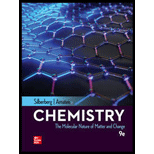
Concept explainers
(a)
Interpretation:
The mass of sulfur in a sample of
Concept introduction:
The law of mass conservation - Introduced by the famous French chemist Antoine Lavoisier, the law states that there is no change in the total mass of the substances that go into any physical or
The law of definite composition - This law can be defined as; a particular compound maintains an exact universal proportion of elements in its composition, irrespective of the source. The proposal for this law was made by Joseph Proust.
The multiple proportions law - The ratio of the weights of an element with variable mass is small whole numbers when it forms more than one compound by combining with an element with fixed weight.
(b)
Interpretation:
The mass fractions of lead and sulfur in a given sample of galena are to be determined.
Concept introduction:
The law of mass conservation - Introduced by the famous French chemist Antoine Lavoisier, the law states that there is no change in the total mass of the substances that go into any physical or chemical reaction.
The law of definite composition - This law can be defined as; a particular compound maintains an exact universal proportion of elements in its composition, irrespective of the source. The proposal for this law was made by Joseph Proust.
The multiple proportions law - The ratio of the weights of an element with variable mass is small whole numbers when it forms more than one compound by combining with an element with fixed weight.
The mass fraction of an element in a compound is defined as the ratio of the sum of the masses of all the atoms of that element to that of the mass of one mole of compound.
(c)
Interpretation:
The mass percents of lead and sulfur in a given sample of galena are to be determined.
Concept introduction:
The law of mass conservation - Introduced by the famous French chemist Antoine Lavoisier, the law states that there is no change in the total mass of the substances that go into any physical or chemical reaction.
The law of definite composition - This law can be defined as; a particular compound maintains an exact universal proportion of elements in its composition, irrespective of the source. The proposal for this law was made by Joseph Proust.
The multiple proportions law - The ratio of the weights of an element with variable mass is small whole numbers when it forms more than one compound by combining with an element with fixed weight.
The mass fraction of an element in a compound is defined as the ratio of the sum of the masses of all the atoms of that element to that of the mass of one mole of compound.
Mass percent of an element represents the percentage concentration of that element in a compound. It is equal to the mass fraction expressed as a percentage. The general formula to calculate the mass percent of an element A in a compound is as follows:
Want to see the full answer?
Check out a sample textbook solution
Chapter 2 Solutions
Chemistry: The Molecular Nature of Matter and Change
- The reaction of solid dimethylhydrazine, (CH3)2N2H2, and liquefied dinitrogen tetroxide, N2O4, has been investigated for use as rocket fuel. The reaction produces the gases carbon dioxide (CO2), nitrogen (N2), and water vapor (H2O), which are ejected in the exhaust gases. In a controlled experiment, solid dimethylhydrazine was reacted with excess dinitrogen tetroxide, and the gases were collected in a closed balloon until a pressure of 2.50 atm and a temperature of 400.0 K were reached.(a) What are the partial pressures of CO2, N2, and H2O?(b) When the CO2 is removed by chemical reaction, what are the partial pressures of the remaining gases?arrow_forwardOne liter of chlorine gas at 1 atm and 298 K reacts completely with 1.00 L of nitrogen gas and 2.00 L of oxygen gas at the same temperature and pressure. A single gaseous product is formed, which fills a 2.00 L flask at 1.00 atm and 298 K. Use this information to determine the following characteristics of the product:(a) its empirical formula;(b) its molecular formula;(c) the most favorable Lewis formula based on formal charge arguments (the central atom is N);(d) the shape of the molecule.arrow_forwardHow does the square root mean square velocity of gas molecules vary with temperature? Illustrate this relationship by plotting the square root mean square velocity of N2 molecules as a function of temperature from T=100 K to T=300 K.arrow_forward
- Draw product B, indicating what type of reaction occurs. F3C CF3 NH2 Me O .N. + B OMearrow_forwardBenzimidazole E. State its formula. sState the differences in the formula with other benzimidazoles.arrow_forwardDraw product A, indicating what type of reaction occurs. F3C CN CF3 K2CO3, DMSO, H₂O2 Aarrow_forward
- 19) Which metal is most commonly used in galvanization to protect steel structures from oxidation? Lead a. b. Tin C. Nickel d. Zinc 20) The following molecule is an example of a: R₁ R2- -N-R3 a. Secondary amine b. Secondary amide c. Tertiary amine d. Tertiary amidearrow_forwardpls helparrow_forwardIndicate the product of the reaction OH OH CH3-CC- Ph + H2SO4 a 20°C | CH3 Pharrow_forward
 ChemistryChemistryISBN:9781305957404Author:Steven S. Zumdahl, Susan A. Zumdahl, Donald J. DeCostePublisher:Cengage Learning
ChemistryChemistryISBN:9781305957404Author:Steven S. Zumdahl, Susan A. Zumdahl, Donald J. DeCostePublisher:Cengage Learning ChemistryChemistryISBN:9781259911156Author:Raymond Chang Dr., Jason Overby ProfessorPublisher:McGraw-Hill Education
ChemistryChemistryISBN:9781259911156Author:Raymond Chang Dr., Jason Overby ProfessorPublisher:McGraw-Hill Education Principles of Instrumental AnalysisChemistryISBN:9781305577213Author:Douglas A. Skoog, F. James Holler, Stanley R. CrouchPublisher:Cengage Learning
Principles of Instrumental AnalysisChemistryISBN:9781305577213Author:Douglas A. Skoog, F. James Holler, Stanley R. CrouchPublisher:Cengage Learning Organic ChemistryChemistryISBN:9780078021558Author:Janice Gorzynski Smith Dr.Publisher:McGraw-Hill Education
Organic ChemistryChemistryISBN:9780078021558Author:Janice Gorzynski Smith Dr.Publisher:McGraw-Hill Education Chemistry: Principles and ReactionsChemistryISBN:9781305079373Author:William L. Masterton, Cecile N. HurleyPublisher:Cengage Learning
Chemistry: Principles and ReactionsChemistryISBN:9781305079373Author:William L. Masterton, Cecile N. HurleyPublisher:Cengage Learning Elementary Principles of Chemical Processes, Bind...ChemistryISBN:9781118431221Author:Richard M. Felder, Ronald W. Rousseau, Lisa G. BullardPublisher:WILEY
Elementary Principles of Chemical Processes, Bind...ChemistryISBN:9781118431221Author:Richard M. Felder, Ronald W. Rousseau, Lisa G. BullardPublisher:WILEY





